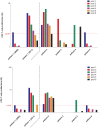Increased HEV seroprevalence in patients with autoimmune hepatitis
- PMID: 24465537
- PMCID: PMC3897432
- DOI: 10.1371/journal.pone.0085330
Increased HEV seroprevalence in patients with autoimmune hepatitis
Abstract
Background: Hepatitis E virus (HEV) infection takes a clinically silent, self-limited course in the far majority of cases. Chronic hepatitis E has been reported in some cohorts of immunocompromised individuals. The role of HEV infections in patients with autoimmune hepatitis (AIH) is unknown.
Methods: 969 individuals were tested for anti-HEV antibodies (MP-diagnostics) including 208 patients with AIH, 537 healthy controls, 114 patients with another autoimmune disease, rheumatoid arthritis (RA), and 109 patients with chronic HCV- or HBV-infection (HBV/HCV). Patients with AIH, RA and HBV/HCV were tested for HEV RNA. HEV-specific proliferative T cell responses were investigated using CFSE staining and in vitro stimulation of PBMC with overlapping HEV peptides.
Results: HEV-antibodies tested more frequently positive in patients with AIH (n = 16; 7.7%) than in healthy controls (n = 11; 2.0%; p = 0.0002), patients with RA (n = 4; 3.5%; p = 0.13) or patients with HBV/HCV infection (n = 2; 2.8%; p = 0.03). HEV-specific T cell responses could be detected in all anti-HEV-positive AIH patients. One AIH patient receiving immunosuppression with cyclosporin and prednisolone and elevated ALT levels had acute hepatitis E but HEV viremia resolved after reducing immunosuppressive medication. None of the RA or HBV/HCV patients tested HEV RNA positive.
Conclusions: Patients with autoimmune hepatitis but not RA or HBV/HCV patients are more likely to test anti-HEV positive. HEV infection should been ruled out before the diagnosis of AIH is made. Testing for HEV RNA is also recommended in AIH patients not responding to immunosuppressive therapy.
Conflict of interest statement
Figures



References
-
- Manns MP, Strassburg CP (2001) Gastroenterology 120: 1502–17.. - PubMed
-
- Manns MP (1993) Intervirology 35: 108–15.. - PubMed
-
- Manns MP (1997) J Viral Hepat 4 Suppl 1: 7–10.. - PubMed
-
- Vento S, Cainelli F (2004) Autoimmun Rev 3: 61–9.. - PubMed
-
- Wedemeyer H, Pischke S, Manns MP (2012) Gastroenterology 142: 1388–1397 e1.. - PubMed
Publication types
MeSH terms
Substances
LinkOut - more resources
Full Text Sources
Other Literature Sources
Medical

